
KCM’s new Nchanga smelter under construction.
Central Africa’s Copper Renaissance
Having doubled output, Zambia’s Copperbelt looks to do it again soon
By Antonio Ruffini, E&MJ African Editor

Zambia has doubled its copper production from 257,000 metric tons (mt) in 2000 to 523,000 mt in 2007. Having doubled once, Zambia’s copper production is set to double again. This view is shared by Frederick Bantubonse, general manager, Chamber of Mines of Zambia, whose members include the country’s main copper producers. Bantubonse explained that with continuing investment in Zambian copper production will exceed 1 million mt/y, and the capacity is being put into place to achieve this.
Konkola Copper Mines (KCM), which operates the Konkola and Nchanga mining complexes and the Nkana smelter, sits at the heart of the Copperbelt. Half a decade ago KCM’s long term future looked bleak as it struggled with high costs and a lack of investment. Today, KCM symbolizes the Copperbelt’s renaissance. The vision of resources conglomerate Vedanta, which took over KCM at the end of 2004, is for KCM to triple its copper production from current levels to 500,000 mt/y. To achieve that, KCM is at last developing the famed Konkola Deeps mining project and, having refurbished its existing Nkana smelter with a nameplate finished copper production capacity of 180,000 mt/y, it is also building a new 250,000 mt/y finished copper capacity smelter at Nchanga, near the town of Chingola.
Shaft sinking contractors have been seen visiting one of the country’s other large scale copper producers, Glencore International’s Mopani Mines. The company operates the long established underground Nkana and Mufulira mines as well as the Mufulira smelter. The Mufulira smelter, which uses Isasmelt furnace technology, is to increase its nameplate processing capacity of 800,000 mt/y to 1.2 million mt/y of concentrate. At about 30% of copper in concentrate that translates to about 360,000 mt/y of finished copper.
In addition, another new smelter being built on the Copperbelt means Zambia will soon have the smelting capacity to produce near 1 million mt of finished copper, before taking into account any solvent extraction electrowinning (SX-EW) facilities in operation. The Chambishi copper smelter, a joint venture between two Chinese companies, state owned behemoth China Nonferrous Metal Mining and more agile private sector company Yunnan Copper Industry (which has a 40% share), is expected to begin production later this year. This smelter, also using Isasmelt technology and being built for about $220 million, is expected to be able to produce 150,000 mt/y of copper.

Another project, Vancouver-based First Quantum Minerals’ 73,000 mt/y Frontier mine, located just across the border in the Democratic Republic of the Congo (DRC), began production in November 2007. It will have a mine life of 19 years. Output from Frontier will increase during 2008 as the mine reaches steady state production levels. Frontier has an on-site crusher, sulphide concentrator, mill and flotation plant—and not everyone is certain whether to count its production as part of Zambia’s Copperbelt or not.
However, there is no such doubt about First Quantum Minerals’ largest copper producer, the Kansanshi mine near Solwezi, which last year approved construction of a fourth tankhouse to brings its on-site electrowinning capacity to 140,000 mt/y of copper cathode. It also uses high pressure leaching to produce copper, or ships concentrate for smelting by Mopani. Kansanshi, an open-pit mine, expects to increase its production from 164,000 mt in 2007 to 181,000 mt this year.
In 2009, the open-pit, heap-leach Muliashi project, which will mine 500,000 mt of ore a month, is expected to begin production. This project, being built by Luanshya Copper Mines (LCM), will see the rapid expansion of this company, which currently produces about 25,000 mt/y of copper in concentrate from its Baluba mine. This concentrate is transported to LCM’s sister company, Chambishi Metals, which has a roaster capable of producing 50,000 mt/yr of copper.
Other producers on the Copperbelt are China’s NFC, and South African junior- to mid-level producer Metorex whose Chibuluma mine will expand production by about 20% to produce about 18,000 mt of copper in concentrate this year.
The Chinese-owned Chambishi smelter and underground mine (not to be confused with Chambishi Metals, LCM’s sister company) is of particular significance. Dirk Kotze, general manager, China, of the Beijing Axis, a business bridge between China and external investors, says that the Chambishi project is China’s flagship mining project on the continent. Its progress is seen by many as a litmus test for the success of Chinese mining in Africa.
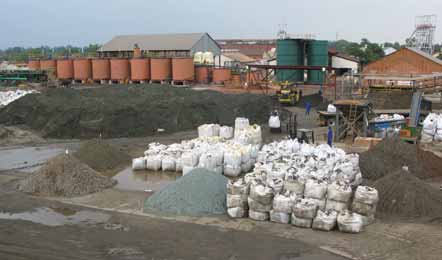
Subsequently, CNMC has been involved in expanding the mine’s processing capabilities and a $25 million SX-EW plant began production in late 2005. Kotze says that so far Chambishi has been dogged by industrial action and complaints about labor conditions, but production is taking place and from a broad perspective the venture can be described as a success. It is expected that the Chambishi smelter will source a large portion of its concentrate from Lumwana.
Taking into account the new projects and expansions by existing operations, it is easy to see that Zambia’s longstanding record of 750,000 mt of copper produced in 1973 will be exceeded. Bantubonse calculates that the Copperbelt could reach the 1 million mt/y of finished copper as early as 2009 and if it misses that mark it may not be by much.
Dave Littleford, who operates Sable Zinc at Kabwe (located halfway between Lusaka and the main Copperbelt), and who worked for the World Bank on the privatization of Zambia’s mining sector a decade or so ago, believes that in real terms, the Copperbelt has never seen higher levels of investment. Bantubonse’s data confirms this. Before six years ago, the average annual investment into Zambia’s mining industry amounted to about $100 million. Over the past six years this has quintupled to average $500 million a year. Employment in the Zambian mining sector has also increased, up from about 19,000 people in 2000 to about 48,000 people today, some of whom are contractors.
An unpredictable factor that could to a degree affect copper production in Zambia is how much and how easily ore will be permitted transport across the border from the DRC for processing within Zambia. This may be pertinent for plants such as First Quantum Minerals’ starter project, the Bwana Mkubwa SX-EW facility just outside Ndola, which produced as much as 45,000 mt/y of copper at its peak a couple of years ago. Bwana Mkubwa’s source of ore, the Lonshi mine across the border in the DRC is near the end of its life. Another operation, the Metorex-owned Sable Zinc facility, which can produce 10,000 mt/y of copper, may not be guaranteed supply from its current primary source, Ruashi in the DRC, after 2008, when Ruashi’s own metal producing facility comes on stream. Littleford, however, is confident that Sable will have no problem obtaining copper and cobalt to process, but the former zinc producer did recently complete the construction of a new 4,000 mt/y zinc plant and in February 2008 began the production of zinc metal from dump material.
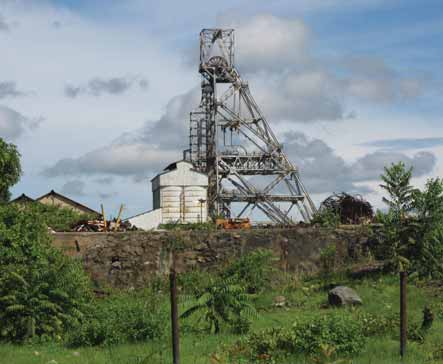
That changed with the development of First Quantum’s Kansanshi project near Solwezi. (Incidentally, First Quantum bought into the Lumwana project in 2007, with about a 17% share). Infrastructure development has seen the highway leading to Solwezi, and now beyond to Lumwana from the main Copperbelt, upgraded. In addition, a 330-kV power line to supply Kansanshi and then Lumwana was put into place.
The open-pit Kansanshi mine consists of the Malundwe and Chimiwungo deposits. The orebodies are 95% sulphide and will be mined using largescale bulk-mining methods. Sulphide ore will be processed on-site by conventional flotation plant with the capacity to treat 20 million mt/y ore to produce copper concentrates. This concentrate will go to off-site smelters. Lumwana will produce copper, in concentrate, equivalent to 169,000 mt/y of copper metal for the first six years. Over the course of its 37-year life, it will average 122,000 mt/y of copper.
Konkola Deeps at Last
The fortunes of Zambia’s copper mining
industry have long been synonymous with
KCM—the largest employer in Zambia’s
mining sector. And, the long-term future
of KCM has always hinged on whether
the Konkola Deeps moved forward. Over
the years, five feasibility studies have
been prepared on the orebody.
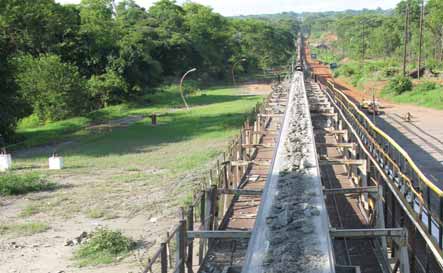
Konkola has been mined down to 950 m and 590 m levels respectively by the existing South (No. 1) and North (No. 3) shafts. Konkola Deeps involves expanding the mine’s ore production from 2 to 6 million mt/y. A new 1,500-m production shaft, No. 4, located near the existing No 1 shaft, is being sunk by Grinaker-LTA. Two rock winders will give the No. 4 shaft a hoisting capacity of 6 million mt/y of ore and 1.5 million mt/y of waste. The larger of the two winders will have a 33- mt payload per skip, and the other a payload of 26-mt per skip. The shaft has an oval shape, with a 9.4-m-wide long axis and a 7-m-wide short axis.
As of mid-January, 2008, the No 4 shaft had reached a depth of 203 m, with the 90m, pre-sink having been completed and the main sink having commenced. South African engineering firm, DRA Technical Services is undertaking the hoist engineering contract while another South African project house, TWP, is responsible for the design of the headgear, shaft steelwork, underground pumping, underground crushing and ore handling, surface substation and electrical reticulation.
“A large pump chamber will be established at the 1,390 m level near bottom of the shaft and a mid-shaft loading facility established at 1,010 m level,” Kulkarni said. “By the end of 2008 we expect some additional ore from Konkola mine when the sinking and equipping project to mid-shaft is completed.” New production levels will be established at the 1,050 m, 1,150 m, 1,250 m and 1,350 m levels.
The Konkola Deeps project also involves extending the No. 1 shaft to a depth of 1,460 m. The development of the lower production levels will take place from both this and the No. 4 shaft. Three new ventilation shafts and a new pump chamber will also be constructed.
The construction plan was selected, based on ore hoisting as rapidly as possible and the first of the two No. 4 shaft winders will start hoisting crushed ore as soon as it can, assisted by the existing shafts. Meanwhile the second winder will be used to complete all infrastructure development, after which both winders will be commissioned for rock hoisting.
“We have looked at the mining method at Konkola, where sub-level open stoping and backfill mining have been used in the past,” Kulkarni said. “We are planning to convert all mining to backfill mining to achieve better extraction rates and lower dilution.”
Two contracts were awarded for primary underground mine development, one to Kitwe-based AAC Mining and one to JIC Mining. KCM, which will undertake secondary development itself, owns and maintains the fleet of mining equipment. This fleet was mainly sourced from Atlas Copco Zambia, Sandvik and Barloworld and comprises normal profile equipment for operation in 4- x 4-m tunnels. It includes 710s, 1020s and 30- to 40-mt dump trucks.
As part of the expansion, a new 6 million mt/y concentrator is being constructed at Konkola adjacent to No. 4 shaft, which eliminates any need for transport of the ore on surface. The existing 2.4- million-mt/y concentrator dates back to the 1950s and its footprint is spread out. FFE Minerals was awarded the concentrator contract, which entails the supply of complete grinding and flotation plants. Primary crushing underground will produce a minus 152-mm product that will go to the milling circuit comprising two SAG and two ball mills. The flotation circuit will use very large cells.
Konkola is one of the world’s wettest mines, and water pumping accounts for 30% of its total mining cost, with 52 large underground pumps used to pump water to the surface via a series of pump chambers. Should the pumps stop operating, the mine would flood within hours. Konkola pumps about 300,000 m3 a day, and this will increase to more than 430,000 m3 a day. After reaching a peak it will stabilize at about 360,000 m3 a day. “The tripling of the mine production will come at relatively small increase in pumping requirement,” Kulkarni said. This economy of scale will assist what is a high cost producer in lowering its copper production costs.
Tripling of the mining rate at Konkola will also help absorb the overhead costs. “In addition, the mining method selected will give us more copper per ton of ore hoisted than at present, the new operation will be more mechanized, and the new concentrator will offer a better recovery and higher levels of automation. However, Konkola will not go to complete automation such as driverless vehicles, taking into account the logistical challenge for a mine in central Africa, where access to spares is seen as a risk,” Kulkarni said.
KCM’s New Smelter; a First for Africa
KCM’s new smelter being constructed to
accompany Konkola Deeps will be only
the third smelter in the world using
Outotec’s direct blister flash smelting
technology, and the first time this technology
is being used in Africa. The other two operations using this technology are
the Olympic Dam smelter in Australia
and the Glogow smelter in Poland.
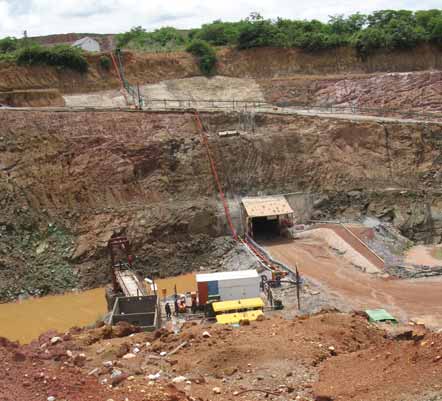
The smelter, which will have two electric furnaces (20 MVA and 15 MVA), will also cast a cobalt alloy as a byproduct, producing about 70 mt/d of cobalt alloy from about a 0.4% cobalt in concentrate feed.
While the smelter’s nameplate capacity is 250,000 mt/y it has been designed for 300,000 mt/y, and the head of Konkola’s smelter project, JR Venkatraman, says that even if Konkola purchases concentrate the smelter’s efficiency will be such that smelting of such ore would be profitable. The smelter is expected to take between three and four years to pay back its capital cost.
Associated with the new Nchanga smelter is construction of a new 1,850- mt/d sulphuric acid plant, which will produce acid from SO2 off-gas and will greatly reduce KCM’s dependence on externally sourced acid. This plant, being built by Furnace Fabrica, and a 750-mt/d oxygen plant that is being built by Air Products of the UK, will respectively be the largest in Africa. The smelter, which will generate temperatures of 1,300°C will also recover waste heat through steam generation at 60 bar with temperatures reduced to 300°C. Alstom Germany is undertaking the waste heat steam generation section of the plant, with Alstom in India and South Africa undertaking the electrostatic precipitation plant work. Swemco of the United States has the contract for the gas cleaning plant. Siemens is undertaking the smelter’s electrics, with Siemens India doing the design and Siemens South Africa assisting with the construction. The distributed control system is being undertaken by Emerson Processing. Durapile of South Africa is undertaking the 5,000 pilings contract.
Venkatraman says that the nature of the Konkola ore with its particular iron sulphur mix led to the decision to opt for the flash smelting process. Typically copper-containing sulphide ores have a ratio of one part copper to one part iron and one part sulphur. “However at Konkola the copper to sulphur ratio of 1.6:1 makes it ideal for the blister flash process. Had the ratio been 1:1 it would have been more suitable to follow a conventional route,” Venkatraman said.
Venkatraman says another major decision taken was locating the new smelter at Nchanga as opposed to at Konkola mine. This was done for safety reasons to minimize acid transport. In April 2006, Kvaerner was engaged to do the detailed engineering, and the ordering of major equipment began in December 2006. Overall, the construction of the smelter is a 26 month project, and target for completion was about mid-2008.
LCM’s Muliashi Project
An operation that illustrates the fall and
rise of Zambia’s Copperbelt is the former
Zambia Consolidated Copper Mines’
(ZCCM) division of Luanshya, owned by
ENYA Holdings since 2004, a joint venture
between the Beny Steinmetz Group
Resources and International Mineral
Resources.
In December 2007, ground clearing earthworks as well as the terracing for the first copper processing leach pads at Muliashi had been completed. Muliashi is the LCM expansion project, with the company’s existing Baluba mine 14.5-km northwest of Luanshya town now close to its maximum extraction capacity of 5,500 to 6,000 mt/d of ore. Baluba produces ore by means of sub-level caving, and LCM COO James Bethel plans for it to reach this maximum ore production capacity over the next couple of years. Baluba mine operates two vertical shafts as well as a decline portal that extends down to the 580-m level. The planned Baluba production increase translates into upping copper production from about 2,000 mt/month about 2,300 to 2,400 mt/month. The LCM concentrator processes 150,000 mt/month of ore, and the plan to increase extraction from Baluba together with some dump reclamation will expand this to 180,000 to 190,000 mt/month.
Luanshya’s story is in miniature the story of the Copperbelt. Unlike Mopani Mines, or KCM to the north, Luanshya had become a Copperbelt backwater and worse. The Luanshya mining complex, which at the peak of its ZCCM days in the 1960s produced 105,000 mt of copper and included a smelter that finally closed in 1999, was atypical when compared with the wetter ZCCM mines further north in the Copperbelt. While drier, Luanshya orebodies were always lower grade, and the other ZCCM operations carried Luanshya. This was always going to be a problem for whoever took over a waning Luanshya as a stand-alone asset.
Unfortunately for Luanshya, when it was first privatized in 1997, the consortium that took it over mismanaged the operation. The operation went into receivership and the three Luansha shafts (Nos. 14, 18 and 28) were shut and are now flooded. As these shafts’ orebodies were largely worked out it is almost certain these shafts will never reopen.
However, as the new large open-pit Kansanshi and Lumwana copper operations to the northwest demonstrate, low grade mines can be highly successful. By extracting the oxide caps, which are relatively low grade—Baluba East as an example has a grade of 1.2% copper— LCM will be following in that vein.
When ENYA Holdings purchased LCM, which comprised the three shut Luanshya shafts and the Baluba mine, the Muliashi oxide caps were not included in that deal.
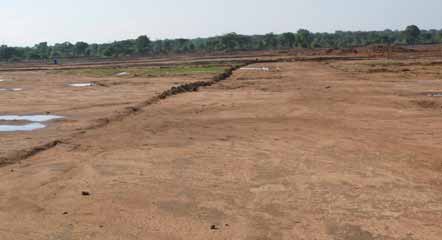
The plan is to mine a number of these Muliashi resources and an exploration campaign to provide more information on them started in early January 2007 and will continue for two to three years.
At a production rate of 500,000 mt/month of ore, Muliashi has a surface life of mine of 12 to 14 years. The heap leach project will establish a copper cathode production facility to process the ore and Bethel says engineering is underway to determine the best plant sizing and optimal process route. At the moment the plan is for four 400- x 1,000-m heap leach pads, each with six 6-m high stacks, for the competent ore, and an agitation leach circuit to be added later for the more friable material. Any sulphide ore will be processed through the Baluba concentrator, which then sells this concentrate to sister company Chambishi Metals for roasting and electrowinning.
The investment in the Muliashi project is estimated at $300 million. Bateman Engineering has been appointed as the project EPCM with all the design work being done out of the company’s Perth office and construction managed from the Bateman Johannesburg office. Teichmann is the contractor doing the earthworks. In December 2007 the mining contract had gone to tender with Turner and Townsend adjudicating this. Bethel anticipates the final award of the contract will take place during the first quarter of 2008, which will give the contractor six to eight months to mobilize prior to commencing mining.
The orebody dips at about 30° and Bethel says it is not complex, though the seam width does vary between 8 and 20 m. The stripping ratio on average will be 4:1 with a copper cutoff grade of 0.3%. The ore is expected to be free dig down to about 12 to 15 m after which drill and blast mining will take place.
The disseminated oxide continues to a depth of about 140 m and when the caps are exhausted Muliashi will need to go underground. The 15-year timeline dovetails neatly with when LCM would need to replace its Baluba sulphide reserves, Baluba having an expected life of about 15 to 20 years.
Considering all of these new mining projects and smelter expansions, it’s plain to see that Zambia’s Copperbelt could reach the 1 million mt/y of finished copper in as little as two or three years. A large cloud, however, hangs over the Copperbelt—the very real specter of windfall taxes. The Zambian government plans to introduce new taxes on copper mines in Zambia. Bantubonse says that some potential producers are now sitting on the fence to see what will happen, though projects that were viable at $1/lb will obviously remain viable. He says that companies will be watching to see how the new proposals affect existing development agreements. This new taxation still has to be discussed by parliamentary committees and the mining industry will still have the opportunity to make its submissions. The government says it has not been reaping the rewards of the quadrupling of metal prices over the past seven years and claims the new taxes will be used to fight poverty in Zambia.